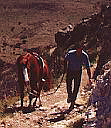Erick Conard's Lucky Hit RanchCotyledonary Placenta |
|
When I was a pre-teen, my dad was able to explain these "gross" red round structures I saw on goat and cow placentae in a very easy to understand way. He called them "buttons." He explained that these "buttons" on the "placenta" snapped onto the uterus to stabilize the placenta in the uterus and to allow food to pass from the mother to the growing embryo. When I was older and received a more "scientific" explanation for these placental structures, I was amazed how accurate his "simple" explanation is. A more scientific explanation follows the definitions. My dad also cautioned me that if I tried to remove the placental membranes forcefully before all of the "buttons" unhook naturally, some of these "buttons" will be left in the uterus to rot and possibly cause infection. (Chemicals produced in the animal's body during birth induce the "buttons" to disengage. However, in some animals this function is less efficient than in others. A warm antibiotic douche can be helpful in these animals. Also, my dad carefully manually removed any "unhooked buttons" in our cows, usually after a stillbirth.) Cotyledon - Cot`y*le"don, n. [Gr. a cup shaped hollow, fr. . See Cotyle.] (Anatomy) -One of the patches of villi found in some forms of placenta. The cotyledon is the structure on the fetal side of the placentae. Cotyledonary placenta - A type of chorioallantoic placenta in which the villi are grouped into tufts or balls separated by regions of smooth chorion. One of a Subset of FOUR PLACENTAL TYPES In 1604, Fabricius introduced a placental classification scheme based upon the macroscopic structure of the sites where attachment occurs between the embryo and the endometrium of the uterus. He listed four main placental types. These are now referred to as the diffuse, cotyledonary, zonary, and discoidal placentas. 1. In diffuse placentae, seen in horses, pigs, camels, lemurs, opossums, kangaroos, and whales, the chorionic sac meets the uterine endometrium over its entire surface. The villi of the chorion are distributed evenly throughout the surface of the chorion, and they extend into processes in the uterine endometrium. (total coverage) 2. Cotyledonary placentae, common to ungulates such as cows, deer, goat, and giraffe, have their villi clumped together into circular patches called cotyledons. The fetal cotyledon meets with maternal regions called caruncles to form the placentome where maternal-fetal exchanges take place. ("buttons") 3. In the zonary placenta, which is characteristic of carnivores, the chorionic villi have aggregated to form a broad band that circles about the center of the chorion. Such zones may be complete circles (such as those in dogs and cats) or incomplete (such as those in bears and seals). It is thought that zonary placentae form from diffuse placentae in which the villi at the ends regress, leaving only those in the center to function. At the edges of the zonary placenta is the hemophagous organ, which is green. The color is due to the degradation of hemoglobin into bilivirdin. This green organ provides iron for the developing fetus. (circular or partially circular band) 4. The discoid placenta is seen in numerous groups -- humans, mice, insectivores, rabbits, rats, and monkeys. In such placentae, part of the chorion remains smooth, while the other part interacts with the endometrium to form the placenta. The maternal blood cells are in direct contact with the fetal chorion. (disc shaped) The Gross Structure of the Cotyledonary Placentae Ruminants have a cotyledonary placenta. Instead of having a single large area of contact between maternal and fetal vascular systems, these animals have numerous smaller placentae. The terminology used to describe ruminant placentation is: 1. Cotyledon: the fetal side of the placenta 2. Caruncle: the maternal side of the placenta 3. Placentome: a cotyledon and caruncle together Caruncles are oval or round thickenings in the uterine mucosa resulting from proliferation of subepithelial connective tissue. Caruncles are readily visible in the non-pregnant uterus. Further, they are the only site in the uterus to form attachments with fetal membranes. Patches of chorioallantoic membrane become cotyledons by developing villi that extend into crypts in the caruncular epithelium. Pregnant sheep, goats and cattle have between 75 and 125 placentomes. Deer also have a cotyledonary placenta, but only 4 to 6 placentomes which are correspondingly larger. During parturition, there is substantial loosening of the cotyledonary villi from caruncles, and the placentomes expand laterally. After expulsion of the fetus and loss of fetal circulation to the cotyledons, capillaries within the villi collapse, leading to a decrease in their size. The uterus contracts and the caruncular stock shrinks, further enhancing the separation of cotyledons from caruncles. In the normal case, fetal membranes with cotyledons are delivered within 12 hours of birth. There is no significant loss of maternal tissue, and therefore, ruminant placentation is considered non-deciduate. |
 Click to Return to Lucky Hit Goats Page
Click to Return to Lucky Hit Goats Page
 Click to Return to Lucky Hit Main Home Page
Click to Return to Lucky Hit Main Home Page